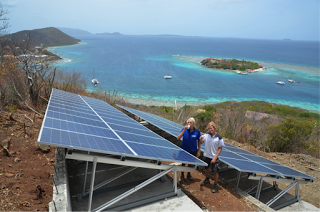

| Online: | |
| Visits: | |
| Stories: |

| Story Views | |
| Now: | |
| Last Hour: | |
| Last 24 Hours: | |
| Total: | |
Renewable reliable desalination
Read aguanomics http://www.aguanomics.com/ for the world’s best analysis of the politics and economics of water I asked Sid Vollebregt to write a guest post about his young company’s technology, which sounds exciting (they’ve got projects running!), but I have not checked out the company’s financials or technology. Please ask for details if you have a project or partnership in mind. — David
In a recent TEDx Talk, we explained how we can produce fresh water sustainably.
Desalinated water production usually requires lots of fossil energy. Desalination already accounts for 1 percent of the global electricity consumption, while it currently only supplies half a percentage of our global water needs. This means that desalination powered by renewable energy is basically the only way forward in order to truly provide a sustainable source of freshwater.
The problem with renewable energy driven desalination is the coupling of fluctuating renewable sources (sun, wind, waves) with the preferred desalination technology, reverse osmosis, which is designed for constant operation. Existing solutions either use batteries or operate discontinuously, resulting in high cost, limited scalability and variable water quality.
Elemental Water Makers delivers affordable, renewable-energy-driven desalination.
Our system uses the renewable energy, for example, solar energy generated by solar panels, which are connected to a seawater pump which displaces the seawater towards an elevated water buffer. This buffer delivers the required pressure for the reverse osmosis process. The elevation difference required is reduced by 80 percent using a mechanical form of energy recovery, re-using the excess pressure still present in the brine flow. For seawater, 90 m is required. Brackish water requires about half the elevation. The elevated water buffer is filled throughout the day and will be able to cover the nights, producing fresh water without any auxiliary power, leading to affordable fresh water.
Here is a summary of our benefits (for details, go here)
- Up to 70 percent savings on electricity usage
- Scalable for community & municipal sized water production
- Reliable and independent water supply
- Green solution without fossil fuels, preventing any greenhouse gas emissions
- Off-grid operation with limited maintenance
- Stress-free operation through remote monitoring
- Silent operation by excluding high pressure pumps & generators
In 2015, Elemental Water Makers delivered their first commercial project in the British Virgin Islands, producing 12.5 m3/day. The end-user saves 63 percent in comparison with his former, conventional fossil electricity driven reverse osmosis unit. Besides cost savings, the project reduces CO2 emissions by 25 tons per year. Here’s a video tour of the installation.
Brine can be a big environmental issue, which is mostly caused by the large difference in salt concentration between the brine itself and the environment (often sea) it is disposed in. In order for our system to allow for an 80 percent decrease in required elevation, the system is forced to run at a low recovery ratio, resulting in more energy to be recovered from the brine and thus a lower required elevation. This 80 percent decrease is only possible when using a very efficient (95 percent) energy recovery process. If we add this together, we get a system, which runs at a low recovery ratio, leading to only a slightly more saline (less than 20 percent) brine discharge, while still being able to run a very efficient desalination process.
Elemental Water Makers does not only provide adaptability on a technological aspect, but also in a social and economical way. Renewable energy driven products will always involve higher investment costs than conventional powered systems, due to the fact that energy is “purchased” up-front, instead of spreading it out over the operational years, as is the case with fossil fuel or grid powered products. Governments, municipalities and general end-users in need for a fresh water solution often do not have the means to cope with these high up front costs. Therefore Elemental Water Makers is also working on Water Purchase Agreements (DBOT). By entering into an agreement for the purchase of the produced water for a certain amount of years, financing can be obtained to cope with the investment. Currently an agreement is entered with a municipality in Cape Verde for a village of 1300 people, who will soon enjoy a 50m3/day reliable and affordable potable water supply, without having to invest. The strength of this project is the combination of immediate cost savings while enabling a safe and sustainable water supply. Simultaneously the Cape Verde system will be used for educational purposes about fresh water scarcity, desalination and renewable energy. This should be an example for all 57 Small Island Developing States who can benefit from this solution.
Bottom Line Elemental Water Makers has a solution, but we need help reaching end-users, decision makers, international agencies, developers, architects and NGOs who can benefit from our technology and knowledge. Please contact us if you want to know more or have some people for us to meet.
Source: http://www.aguanomics.com/2016/12/renewable-reliable-desalination.html




